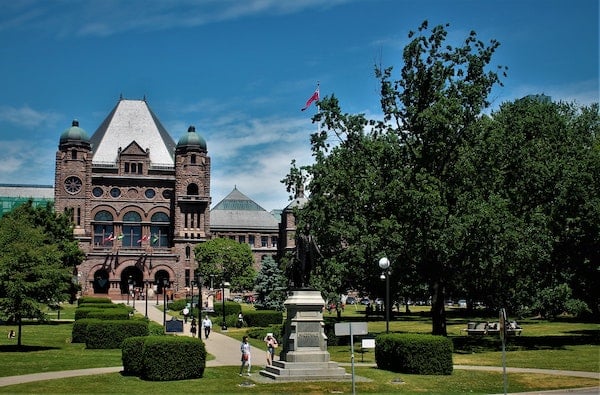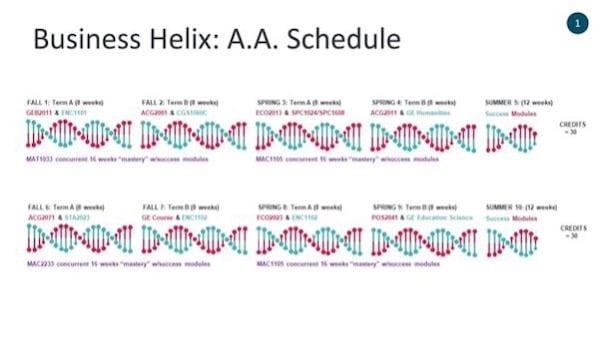Published on
The Unicorn: Merging Liberal Arts and Career and Technical Education for the Future of Work

Helix Curriculum, or the process of fully blending two or more courses into one sequence of learning experiences taught by two or more faculty from different disciplines.
Planning your education in a complex molecular economy
Jayden sat on a chair on the balcony outside her mother’s small apartment. It had been yet another long week of waiting on tables and keeping up with her classes. She took out her phone, opened an app and began to interact. It was 2:00 AM when she heard the door open and her mother walk in. Her mom set down a few groceries and let out a sigh as she collapsed on the couch. Rolling her head toward the cooler air coming from the open glass door, she saw Jayden illuminated by the glow of her screen. Rising quickly and approaching Jayden from behind, her mother exclaimed, “Jayden!” Seeing she had startled her daughter, she lowered her voice, “You need to be resting, child, not playing on your phone. I know you worked tonight too and have a class early this morning.” Jayden started to say something when her mother realized that displayed on her daughter’s device was an interface with financial information. “I’m not playing, mom. This is homework. I’m buying and selling real stocks on the market, and this is the only time I have to research before the market opens tomorrow.”
Her mother saw a total of $787 beside the portfolio total. “You mean you have over $700 in the bank?” Jayden replied, “It’s not actually a bank but I’m investing in Crypto Currency. I’ve found a few other stocks I like and bought those too. In one of my classes, Professor Dorval has enrolled me in a project supported by the college’s Foundation. In the project, each student received $500 to invest. We have to leave it there until the end of the term, and then we can put what’s left into our education costs or keep it. It’s part of our FinTech classes. I’m learning that the economy is like a molecule, mom—complex and adapting every day as the environment changes. Different pieces combine and create new technologies and companies all the time. I’m looking for those patterns. I have some left from my tips tonight, and I’m adding a bit to my portfolio. If I can keep it up, I can help a lot more with our bills and even leave more for my education.”
Jayden heard a sound she had not in many years. She turned around and saw a small tear from her mother’s eye. “Why are you sad, mom,” she asked? “Did someone upset you at work?” “No, sweetheart,” her mother said. “In all the generations of our family, no one has ever owned stocks or anything like it. It’s been such a long struggle to survive each day. You are the first, sweetheart. You are the first in so many ways.” Jayden hugged her mother. “You keep investing,” her mother insisted. “This is more than a side–hustle. This should always be part of what you do.” Jayden smiled excitedly. “Now show me what you have in your account, and tell me why you picked those,” she said as she pulled up another chair and sat beside her daughter.
The age of agility and the future of work
According to modern economists, we now live in the Second Machine Era—an era in which artificial intelligence, robotics, unmanned systems, and data analytics are changing the very nature of what we commonly call work. Employers are increasingly asking for the next-generation workforce to possess what The Florida 2030 Chambers’ Foundation calls “employability skills.” This future-proof strategy provides a blueprint to address the relatively lower income of Floridians and the critical skills gap between our current workforce and what 21st-century business and industry demand. Secondary and post-secondary education must undergo significant change if we are to assure the talent pipeline meets the needs in areas such as information technology, aerospace, health care and life sciences, manufacturing, logistics and distribution, and financial and professional services (representing 30% of Florida’s jobs and over 40% of the gross state product). Whatever state you live in, you can likely find similar metrics moving in the same direction. Welcome to the Age of Agility.
Today, we sit at the confluence of demand for skill specific jobs across a rising number of shorter-term badges and data that continue to show the economic and lifelong value of higher education degrees. In the 2018 book Branches from the Same Tree, the National Academies of Sciences, Engineering, and Medicine continue to examine the growing evidence behind the assertion that educational programs that mutually integrate learning experiences in the humanities and arts with science, technology, engineering, mathematics, and medicine (STEMM) lead to improved educational and career outcomes for students. It is rapidly appearing that a mixture of the liberal arts combined with one or more lucrative career fields more commonly found in applied sciences may prove to be the best way forward.
The unicorn of integrating liberal arts and career and technical education
Not so long ago, liberal arts pathways fell under a barrage of criticism. Focus shifted toward science, technology, engineering, and mathematics as well as skilled trades and fields. This focus was primarily grounded in the perception that “softer” degrees across interdisciplinary sciences had less applicability in the economic landscape. But the liberal arts focus on the very employability skills in high demand in our complex adaptive economy; creativity, problem-solving, teamwork, critical thinking, and more, are highly valued by employers today. Such skills are particularly in demand across STEM and related occupations. Recently, the mix of liberal arts with skilled trades and career and technical certificates as well as STEM pathways create a new agile graduate—someone employers often call a “unicorn”.
We are all pursuing our unicorn, that career and life so beautiful we can only compare it to the mythical beast of beauty and extraordinary power and purity. Entire nations seek to produce armies of such unicorns, lifting their GDPs and quality of life above all others. Producing and expanding talent chains through economic policies occurs each day on the local, regional, and national levels. Such systems often indicate the deep cultural values of those regions and nations. The Germanic guilds and educational systems have created one of the strongest economies in the world through largely linear talent alignment and apprenticeships. Most Germans keep to selected career ladders and seldom change in an economy designed for this proficiency. In a recent article from the BBC, Barbara Woolsey introduced many to the term used in Germany to describe an increasing number of individuals changing careers: Quereinsteiger for men and Quereinsteigerin for women. They are used in negative connotation and come with a stigma failure in a previous career. Woosley notes that German politicians are becoming aware of the benefits of career changers, in part from Chancellor Angela Merkel (a research scientist before entering politics) destigmatizing career changes via an official webpage for Quereinsteiger, featuring interviews and tips on changing careers.
Here on the home front, there is a commonly shared statistic that Americans change careers roughly seven times over a lifetime. However, no one really knows the actual average number of careers. The U.S. Bureau of Labor Statistics (BLS) does not track lifetime careers. The BLS has even included a corrective memo on its website, explaining that “no consensus has emerged on what constitutes a career change.” Yet, we as Americans readily accept and even encourage individuals to change career pathways as economic realities change. Perhaps it is somewhat ironic that higher education has attempted to move largely in an opposite direction under a “pathways” effort to reduce or eliminate excess credit hours and increase attainment. As leaders in higher education, we are quite familiar with such efforts and criticism surrounding them, namely that such approaches can restrict the benefits of a college experience, enabling exploration of many majors and fields as individuals develop and mature over time. Clearly, we cannot sustain funding educational planning that does not culminate in some type of credential. Nor should we totally restrict the revelation so many students experience as they often accidentally find a class (usually connected to a remarkably talented professor) that leads to an unexpected choice for the future. So, what do we do? Enter the Helix…
The Helix curriculum and learning pavilions
Colleges and universities have long been exploring the merger of two or more courses. Interdisciplinary studies have a long history, as do multidisciplinary approaches across a wide variety of subjects. Some colleges are particularly known for this, such as Allegheny College’s Unusual Combinations, Kalamazoo College’s K-Plan, through which students develop their own interdisciplinary majors, or Hendrix College’s innovative Odessy program in which all students are guaranteed experiential learning opportunities. Such examples are growing as liberal arts colleges struggle to convey the value proposition in a differentiated economy. Exploring the full integration of two or more subject areas, encouraging deep faculty collaboration across disciplines creating “block” schedules through which students can experience “deeper immersion” in material through job shadowing, internships, and apprenticeships, and even the embedding of badges and workforce certificates within general education courses all point to a new “helix” developing across our curriculum.

Imagine that helix molecule that so many of us know when we picture DNA. The twisted pairing of liberal arts and STEM/career pathways offers an adaptive ladder that rapidly adjusts to changes in the environment. Above is a basic example of where we go beyond the contextualization of a course to a fully integrated helix degree. As the economic landscape changes, we recombine the DNA of our curriculum and programs. Traditional academic silos shift to adaptive combinations targeting employability while continuing to emphasize agility. Our classes evolve to clusters of recombinant learning outcomes via faculty curated lessons and assessments. These teaching and learning artifacts are also reviewed on a frequent basis by employers for both overall employability skills (soft skills) and discrete skills aligned with employment opportunities. Teams of faculty and employers work together to adapt programs beyond traditional advisory groups into deeper collaboration and new partnerships through activated collegiality (see the National Convergence Technology Center’s B.I.L.T. framework for a powerful example). All of this is buttressed by AI and predictive analytics empowering faculty and college leaders with data from job search engines as we see today through Burning Glass, Personio, Cantalop and others.
As the shifting helix takes hold in this emerging economy, our campuses and facilities, too, begin to shift. Student life becomes a thematic pursuit across campus and not a designated area of escape from academia. Our traditional clustering of buildings by discipline evolve to “learning pavilions”, each equipped with ideation and creation spaces, maker spaces, community engagement and forum venues, digital drop zones for social media influence and digital dexterity, and student–driven event and commerce zones. Some classrooms still exist, but the majority of our square footage is devoted to agility and equipped for combinations such as Complementary Alternative Medicine, combining empirically supported stress reduction therapies and traditional health care programs. Our gyms and athletic facilities become personal training zones with micronutrient juice bars made from produce grown by our students in the nearby atrium. Students flow into our CryptoHub and Blockchain Coffee Shop, where screens display market updates and assignments range from simulated to controlled but actual investment training. The deep analysis of economic trends drives everything, with faculty and employers creating all new combinations for the ever-changing helix.
How do we get there from here?
I hope you are continuing to enjoy this series of articles. As an administrator and educator for over 30 years, I am not blind to the utopian vision offered herein, nor am I inexperienced with the complex human factors often associated with systemic change. In working with my faculty across three institutions of higher education, we have made remarkable progress. At one college, we worked with the faculty senate to create a “levels of engagement” index and set class sizes based on the required frequency of specific academic feedback. At another, we integrated industry-recognized certificates into general education courses and changed faculty load based on the degree of autonomy in their courses.
Our funding formulas and loads are based on average seat counts, so we leveraged bots to assist in auto-grading and increased class sizes in some sections to lower class sizes in others and enable faculty to spend more time with students in need. We have built major facilities exceeding 100,000 sq ft, with each classroom differently equipped to increase student engagement with unique floor plan and technology designed in collaboration with faculty. We are just beginning to attach predictive analytics at the learning object level to increase student retention and attainment across hundreds of courses. Despite the increasingly dire predictions for the future of higher education, I believe we will more than prevail. We will thrive in our creativity across shared governance, new dimensions of scholarship, and an activated collegiality driven by technology and data. And more so across a talented and dedicated field of colleagues who serve our students and community. Maybe there is no such thing as a “real” unicorn. Yet, I see them every day across our college.
Professor Dorval stood in front of the gathering sitting on the lawn before her. Beside her were representatives from the College Foundation. “Today we are here to thank our Foundation and announce the winners of our Crypto Currency Challenge,” said Dorval. “As we all agreed, a portion of our proceeds has been directed to our county’s Promise Tomorrow Inc., serving local children and families who have been removed from their homes due to domestic violence, substance abuse, physical and/or sexual abuse, and abandonment. Thanks to your efforts and the support of our foundation, we have created 15 Life Promise scholarships for these families.” Jayden couldn’t help but smile as she edged closer to the front of the crowd. “And now the winner,” started Professor Dorval as she made eye contact with Jayden. “Jayden, please come forward.” Jayden lowered her head in modesty as she stepped up to the stage at the front of the learning pavilion. “She may not know this,” continued Dorval, “but as project leader I can see that this young lady invested twice the number of hours of research as average participants. Her research led her to a little-known Crypto opportunity now exceeding 70% of its original value. Congratulations Jayden!” exclaimed the professor as she handed Jayden an envelope. Jayden moved to the microphone and began, “This is for you, mom, for your love and enduring support.” Across town, Jayden’s mom was beaming with pride as she tuned in at the neighborhood WiFi hotspot via the link Professor Dorval had sent to her the night before. Tugging on her dress, Jayden’s younger sibling asked, “What’s a Crypto, Mom, and how did Jayden learn to ride it?” “Shhh,” whispered her mom. “She told me she’ll teach you all about it when she gets home.”
This article is the third segment to a series. To read the previous segment, click here.
Disclaimer: Embedded links in articles don’t represent author endorsement, but aim to provide readers with additional context and service.
Author Perspective: Administrator



